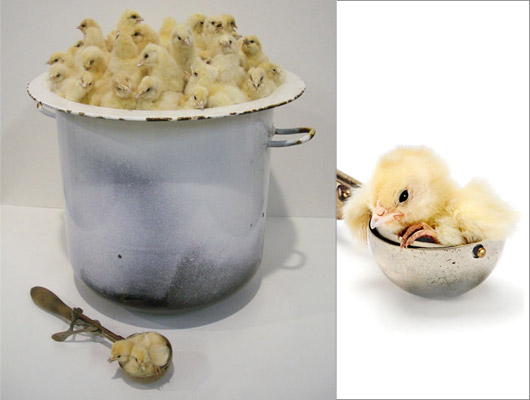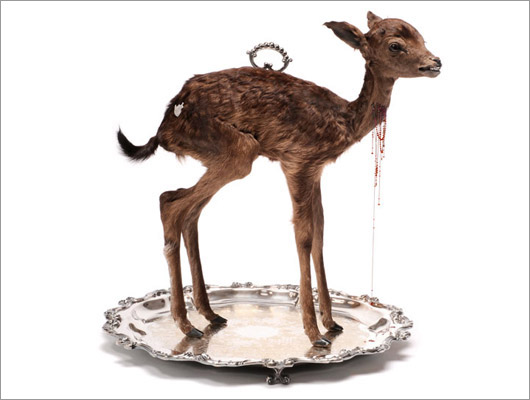Women in Art: Sarcophagus
By Lauren Treiser Dead animals have been Julia deVille's medium of choice for many years now. The title of her latest show is Sarcophagus and includes works that communicate the atrocities that go on in the meat, egg and dairy industries. Julia is not a fan, to say the least, of commercial farming methods and can recite in horrific detail the atrocities she says are committed in the name of putting food on our plates. The message she is emphasising in this show is obviously one that she is passionate about even to the point of putting animal activist flyers alongside the room sheet in the gallery. The pieces in the exhibition are both beautiful and confronting.
 It's a wonderful life
2012
Image from Sophie Gannon Gallery
It's a wonderful life
2012
Image from Sophie Gannon Gallery
Entering the gallery I was struck by the stag hanging from the ceiling with rubies falling from its neck into a jar below. It's a wonderful life forms the centrepiece of the exhibition and goes a long way in filling me with both shock and awe. In the introduction to the catalogue, David Walsh, owner of MONA (Museum of Old and New Art) in Tasmania, writes that his display of hanging meat in his gallery was likened to building glass walls for the slaughterhouse. And I believe that this is what Julia is doing with this piece.
 Custard
2012
Image from Sophie Gannon Gallery
Custard
2012
Image from Sophie Gannon Gallery
On the one hand some of the animals look cute until you take in their surroundings, sitting in a pot or perched on a silver serving tray. Some animals, like the large deer which is seated directly on the table, has only the recognisable handle of a cloche in its back and bloodied cutlery next to it. Others seem peacefully laid out but upon closer inspection little blood spots which are precious stones appear to be set in their body. The names that Julia has given each piece give the audience an insight into the bad treatment that animals experience at our expense for a delicious meal. For example, the antique ice-cream vat full of chicks is called Custard, and puts into question how sometimes we are not even aware that caged eggs have been used in a dish. So in fact once you consider the artist’s message, the animals no longer look cute at all!
 Majesty
2012
Image from Sophie Gannon Gallery
Majesty
2012
Image from Sophie Gannon Gallery
 Lamington
2012
Image from Sophie Gannon Gallery
Lamington
2012
Image from Sophie Gannon Gallery
The comeback of taxidermy in recent years has slightly altered the general public's perception, making it a more accepted medium. In spite of this the most confronting part of the show for me were the lambs. I am a meat eater and these pieces made me uncomfortable, almost squeamish. They certainly made me think twice about what ingredients I use.
 Sentience
2012
Image from Sophie Gannon Gallery
Sentience
2012
Image from Sophie Gannon Gallery
Being both a passionate vegetarian and a person who feels very strongly about the fair and just treatment of animals, Julia only uses animals that have died of natural causes. This certainly goes a long way in making it easier for her audience to digest her work. She finds dead birds and mice lying around but most of her subjects are donated to her by friends and strangers.
She obviously wants people to really question their eating habits and realize that no matter how something is served up to them, they have to be aware of what has happened to the animal before it reached their table. “A lot of people eat meat but don't want to be confronted with what they're doing,'' she said. ''They're choosing to be ignorant in a way.''
 Mishicanca
2012
Image from Sophie Gannon Gallery
Mishicanca
2012
Image from Sophie Gannon Gallery
Julia deVille is a jeweller and a taxidermist whose work explores life's big questions: mortality, spirituality, nature and history. Julia has exhibited at the NGV, MCA and has pieces in the MONA collection. She has always been fascinated by the aesthetic used to communicate mortality in the Memento Mori period of the fifteenth to eighteenth centuries, as well as the methods the Victorians used to sentimentalise death with adornment.
She works predominately in traditional gold and silversmithing techniques, combined with materials that were once living such as jet, a petrified wood historically used in Victorian mourning jewellery, and of course taxidermy.
Julia describes her own work as “peacefully dark,” and has grouped her arts and commercial practices under the banner Disce Mori (learn to die), indicating her diligent exploration of the visual language of death.
 Gilt
2012
Image from Sophie Gannon Gallery
Gilt
2012
Image from Sophie Gannon Gallery
Although I am not sure if her show will achieve what she has set out for it, which is to change the way people consume animal products, it certainly highlights for the audience the ill-treatment suffered by animals and at least gets them thinking! I am fascinated by each setup in the exhibition and this is definitely a show worth seeing for yourself. The detail and the little messages that Julia has imbued within each piece can only be truly appreciated in person.
 Genocide
2012
Image from Sophie Gannon Gallery
Genocide
2012
Image from Sophie Gannon Gallery
Something that piqued my interest during my research was that to prove her dedication to her art form, Julia has donated her body to Germany’s renowned Institute for Plastination. What this means is that after her death, her body will be dissected, filled with a special polymer and exhibited. She feels that if she can do this to animals it is only fair it should be done to her.
Julia deVille’s jewellery is sold throughout boutiques across the world. To learn more about Julia and her work visit juliadeville.com
Sarcophagus Sophie Gannon 2 Albert Street, Richmond, Melbourne 24 July – 1 Sept Gallery Hours: Tuesday – Saturday, 11am – 5pm
Lauren is graphic designer and founder of patchyrugs.com.au. She loves all things design (see her blog at blog.ilovelollies.net) and is particularly passionate about fine art, interior design and jewellery. Lauren is currently studying Gold & Silversmithing and doing graphic design on a freelance basis.
